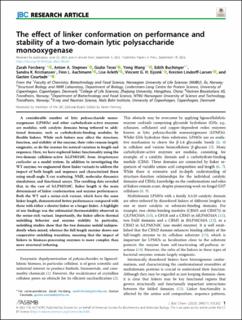| dc.description.abstract | A considerable number of lytic polysaccharide monooxygenases (LPMOs) and other carbohydrate-active enzymes are modular, with catalytic domains being tethered to additional domains, such as carbohydrate-binding modules, by flexible linkers. While such linkers may affect the structure, function, and stability of the enzyme, their roles remain largely enigmatic, as do the reasons for natural variation in length and sequence. Here, we have explored linker functionality using the two-domain cellulose-active ScLPMO10C from Streptomyces coelicolor as a model system. In addition to investigating the WT enzyme, we engineered three linker variants to address the impact of both length and sequence and characterized these using small-angle X-ray scattering, NMR, molecular dynamics simulations, and functional assays. The resulting data revealed that, in the case of ScLPMO10C, linker length is the main determinant of linker conformation and enzyme performance. Both the WT and a serine-rich variant, which have the same linker length, demonstrated better performance compared with those with either a shorter linker or a longer linker. A highlight of our findings was the substantial thermostability observed in the serine-rich variant. Importantly, the linker affects thermal unfolding behavior and enzyme stability. In particular, unfolding studies show that the two domains unfold independently when mixed, whereas the full-length enzyme shows one cooperative unfolding transition, meaning that the impact of linkers in biomass-processing enzymes is more complex than mere structural tethering. | en_US |

